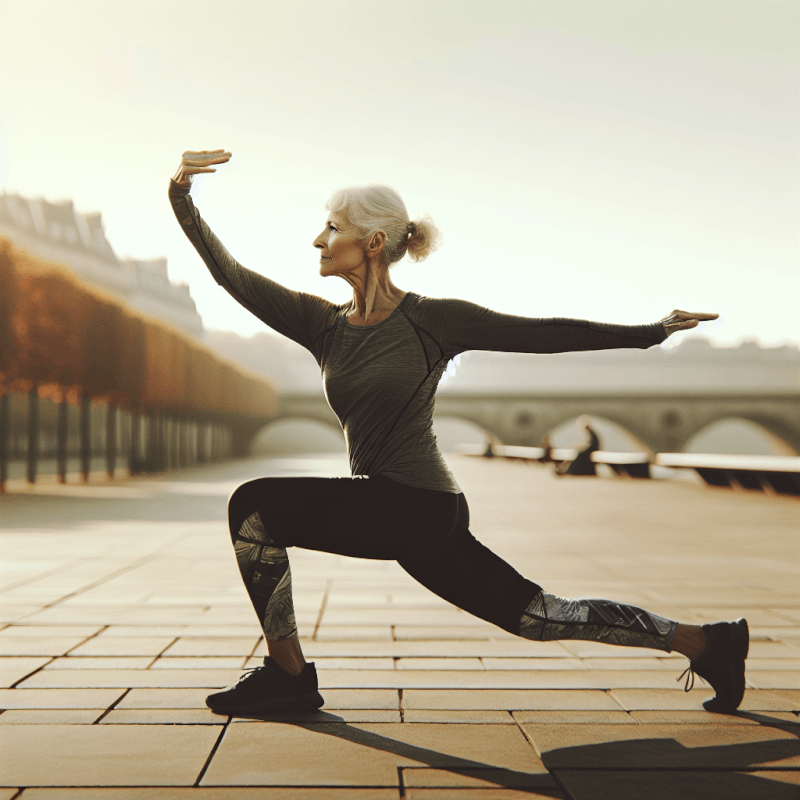Are you over 50 and looking for an effective workout routine that is both fun and challenging? Look no further than calisthenics! Calisthenics is a form of exercise that uses your body weight to build strength, flexibility, and endurance. In this article, we will explore a specially designed calisthenics workout tailored for individuals over 50. Say goodbye to monotonous workouts and join the calisthenics movement today!

Benefits of Calisthenics Workout for Over 50s
Improved Strength and Muscle Tone
One of the biggest benefits of calisthenics workouts for individuals over 50 is the improvement in strength and muscle tone. As we age, our muscle mass tends to decrease, leading to a loss of strength and mobility. Calisthenics exercises, which involve using your own body weight for resistance, help to build and maintain muscle mass. By incorporating exercises like squats, push-ups, lunges, and planks into your routine, you can target different muscle groups and gradually increase your strength. This increased strength not only allows you to perform daily activities more efficiently but also reduces the risk of injuries and falls.
Enhanced Balance and Flexibility
Another advantage of calisthenics workouts for individuals over 50 is the improvement in balance and flexibility. As we age, our balance naturally declines, making us more prone to falls and injuries. Calisthenics exercises that focus on core strength, such as planks and tricep dips, help to improve balance by strengthening the muscles in the abdomen, lower back, and hips. Additionally, practicing calisthenics can also enhance flexibility, making it easier to perform daily tasks and maintain a full range of motion in joints.
Weight Management and Increased Metabolism
Calisthenics workouts can also aid in weight management and increasing metabolism for individuals over 50. Regular exercise, including calisthenics, helps to burn calories and build lean muscle mass. As muscles require more energy to function, having a higher muscle-to-fat ratio can increase your resting metabolic rate. This, in turn, can help with weight management and prevent weight gain or even promote weight loss. Furthermore, calisthenics workouts can help maintain healthy blood sugar levels, regulate cholesterol levels, and improve cardiovascular health.
Reduced Risk of Chronic Diseases
Engaging in regular calisthenics workouts can significantly reduce the risk of chronic diseases for individuals over 50. Studies have shown that physical activity, including calisthenics, can lower the risk of conditions such as heart disease, stroke, type 2 diabetes, and certain types of cancer. Regular exercise helps to regulate blood pressure, improve blood circulation, and boost the immune system, all of which contribute to a healthier and more resilient body. By incorporating calisthenics into your routine, you can improve your overall health and well-being.
Improved Bone Density and Joint Health
Bone density and joint health are vital concerns for individuals over 50, as the risk of osteoporosis and joint pain increases with age. Calisthenics exercises that involve weight-bearing movements, such as squats and lunges, help to improve bone density, reducing the risk of fractures and osteoporosis. Additionally, calisthenics workouts help to strengthen the muscles surrounding the joints, improving stability and reducing the risk of joint injuries. By regularly engaging in calisthenics, you can promote healthier bones and joints, enhancing your overall mobility and quality of life.
Getting Started with Calisthenics at 50+
Consult Your Doctor or Healthcare Provider
Before starting any new exercise program, it is important to consult with your doctor or healthcare provider, especially if you have any pre-existing medical conditions or injuries. They can assess your current health status and provide guidance on the suitability and safety of calisthenics workouts for you. Your doctor or healthcare provider can also give you recommendations specific to your needs and may suggest modifications to exercises or activities to accommodate any limitations you may have.
Start with a Warm-Up
Starting your calisthenics workout with a proper warm-up is crucial, especially for individuals over 50. A warm-up helps to increase blood circulation, raise the body temperature, and prepare the muscles and joints for the upcoming workout. It can include dynamic stretches, light cardio exercises, and joint mobilization movements. Aim to spend at least 5-10 minutes warming up before diving into your calisthenics routine.
Choose the Right Exercises
When starting calisthenics at 50+, it is important to choose exercises that work for your body and fitness level. Focus on exercises that target different muscle groups and promote overall strength and stability. Squats, push-ups, lunges, planks, and tricep dips are excellent choices that can be modified to suit your abilities. It is important to start with exercises that are manageable, gradually increasing the intensity and difficulty as you progress. Remember to always listen to your body and prioritize your safety.
Learn Proper Form and Technique
Learning and practicing proper form and technique is essential for getting the most out of your calisthenics workout as an individual over 50. Proper form not only enhances the effectiveness of the exercises but also reduces the risk of injuries. Take the time to learn the correct posture, alignment, and movement patterns for each exercise. Consider working with a qualified fitness professional who can guide you through the proper techniques and provide feedback to ensure you are performing the exercises safely and effectively.
Set Realistic Goals and Progression
Setting realistic goals and focusing on progression is key to a successful calisthenics journey at 50+. It is important to understand that progress may be slower compared to when you were younger, and that’s okay. Start with attainable short-term goals and gradually build on them as you become stronger and more comfortable with the exercises. Celebrate small achievements along the way, whether it’s managing an extra repetition or holding a plank for a few seconds longer. Remember, consistency and patience are key to long-term success.
Recommended Calisthenics Exercises for Over 50s
Squats
Squats are a fundamental calisthenics exercise that targets multiple muscle groups, including the quadriceps, hamstrings, glutes, and calves. To perform a squat, stand with your feet shoulder-width apart and slowly lower your hips down as if you were sitting back into a chair. Keep your chest lifted and core engaged throughout the movement. Lower until your thighs are parallel to the ground, and then push through your heels to return to the starting position. Squats can be modified by using a chair for support if needed.
Push-Ups
Push-ups are an excellent exercise for targeting the chest, shoulders, triceps, and core muscles. To perform a push-up, start in a plank position with your hands slightly wider than shoulder-width apart. Lower your body towards the ground by bending your elbows, keeping your body straight and your core engaged. Push through your arms to return to the starting position. If performing push-ups on the floor is challenging, you can modify them by performing them against a wall, counter, or using an elevated surface like a bench.
Lunges
Lunges are a great lower body exercise that targets the quadriceps, hamstrings, glutes, and calves. To perform a lunge, start by standing with your feet hip-width apart. Take a step forward with one foot, bending both knees to lower your body towards the ground. Make sure your front knee stays above your ankle and your back knee hovers just above the floor. Push through your front heel to return to the starting position. Lunges can be modified by holding onto a stable surface for balance if needed.
Planks
Planks are an effective exercise for strengthening the core, shoulders, and back muscles. To perform a plank, start by lying face down with your forearms on the ground and your elbows directly beneath your shoulders. Engage your core and lift your body off the ground, resting on your forearms and toes. Keep your body in a straight line from head to toe, avoiding any sagging or lifting of the hips. Hold the position for as long as you can while maintaining proper form. If the full plank is too challenging, you can modify it by performing it on your knees instead.
Tricep Dips
Tricep dips are a great exercise for targeting the triceps, chest, and shoulders. To perform tricep dips, sit on the edge of a chair or bench and place your hands on either side of your hips. Walk your feet forward and lift your hips off the chair, keeping your knees bent. Slowly lower your body by bending your elbows, allowing your hips to drop towards the ground. Push through your palms to raise your body back up to the starting position. Tricep dips can be modified by keeping your feet closer to the chair or using a step stool for more assistance.
Modifications and Adaptations for Over 50s
Incorporate Resistance Bands
Incorporating resistance bands into your calisthenics workout can provide added resistance and help you build strength gradually. Resistance bands are portable, affordable, and can be used to target various muscle groups. They can be added to exercises like squats, lunges, and push-ups to increase the challenge and stimulate muscle growth. With resistance bands, you can easily adjust the resistance level by choosing bands of different thickness or by altering the length of the band.
Use Elevated Surfaces
Using elevated surfaces can be helpful for individuals over 50 who may have difficulty with traditional floor exercises. Elevated surfaces like benches, stairs, or stability balls can assist in modifying exercises while still providing a challenging workout. For example, push-ups can be performed with hands on an elevated surface, making it easier to maintain proper form and build upper body strength. Similarly, lunges can be performed with the front foot elevated on a step or bench to reduce strain on the knees.
Opt for Lower-Impact Variations
Opting for lower-impact variations of exercises can be beneficial for individuals over 50, especially if they have joint pain or limitations. Instead of high-impact exercises like jumping jacks or burpees, choose exercises with low impact, such as marching in place, step touches, or modified jumping jacks without the jump. These exercises provide cardiovascular benefits without putting excessive stress on the joints. Remember to always listen to your body and choose exercises that feel comfortable and pain-free.
Take Sufficient Rest and Recovery
Rest and recovery are essential components of any exercise program, especially for individuals over 50. Give your body enough time to recover between workouts to prevent overuse injuries and promote muscle growth. It is recommended to have at least one or two rest days per week. During rest days, focus on gentle stretching, foam rolling, or engaging in activities like walking or yoga to promote circulation and flexibility. Adequate sleep and proper nutrition also play a significant role in recovery and overall health.

Designing a Calisthenics Workout Routine for Over 50s
Full-Body Workouts
Full-body workouts that target all major muscle groups are a great option for individuals over 50. These workouts ensure that your entire body is engaged and balanced, promoting overall strength, muscle development, and functional fitness. A typical full-body calisthenics workout could include exercises like squats, push-ups, lunges, planks, tricep dips, and additional exercises that target the back, biceps, and core. Aim to perform each exercise for a certain number of repetitions or for a set duration, depending on your fitness level and goals.
Split Workout Routine
Alternatively, a split workout routine can be beneficial for individuals over 50 who prefer a more targeted approach or have specific areas they want to focus on. In a split routine, you divide your workouts into different muscle groups or body parts over the course of several days. For example, you could have one day dedicated to upper body exercises like push-ups and tricep dips, and another day focused on lower body exercises like squats and lunges. This approach allows for more concentrated efforts and gives specific muscle groups ample time to recover.
Progressive Overload
Incorporating progressive overload into your calisthenics routine is crucial for continued improvement and growth. Progressive overload means gradually increasing the demands placed on your muscles over time. This can be achieved by adding repetitions, increasing the duration or intensity of exercises, or by incorporating variations that provide a greater challenge. For instance, you can start with performing 10 push-ups and aim to increase the repetitions by one or two each week until you reach your desired goal. Progressive overload stimulates muscle adaptation and helps to avoid plateauing in your fitness journey.
Frequency and Duration
The frequency and duration of your calisthenics workouts will depend on your fitness level, goals, and personal preferences. As a general guideline, aim to engage in moderate-intensity calisthenics workouts for at least 150 minutes per week. You can divide this into sessions of 30 minutes, five days a week, or adapt it to fit your schedule. Remember to prioritize rest days for recovery, allowing your muscles and joints to recuperate and grow stronger. It’s always essential to listen to your body and make adjustments as needed to prevent overtraining or burnout.
Tips for a Successful Calisthenics Workout at 50+
Listen to Your Body
Listening to your body is crucial for a successful calisthenics workout, especially as an individual over 50. Pay attention to any pain or discomfort during exercises and modify or stop if necessary. It’s normal to feel muscle fatigue or mild soreness, but sharp or persistent pain should not be ignored. If an exercise doesn’t feel right for your body, find alternatives or seek guidance from a qualified fitness professional. The key is to challenge yourself within your limits and prioritize safety and long-term well-being.
Stay Consistent and Patient
Consistency and patience are essential when starting a calisthenics workout at 50+. Results may not be immediate, but by sticking to a regular workout routine, you will gradually see improvements in strength, flexibility, and overall fitness. Celebrate small victories along the way and focus on the process rather than solely the outcome. Rome wasn’t built in a day, and the same goes for your fitness journey. With time, dedication, and consistency, you will achieve your goals and enjoy the many benefits of calisthenics.
Stay Hydrated
Proper hydration is crucial before, during, and after your calisthenics workouts. Water plays a vital role in regulating body temperature, lubricating joints, and aiding in muscle function. Make sure to drink water before your workout and continue to hydrate throughout the session. The exact amount of water needed varies depending on factors such as climate, intensity of exercise, and individual needs. Listen to your body’s thirst signals and drink enough water to stay properly hydrated.
Include Mobility and Stretching Exercises
Incorporating mobility and stretching exercises into your calisthenics routine is important for maintaining joint health and flexibility. As we age, our mobility can decrease, making it even more essential to focus on exercises that promote joint range of motion. Gentle stretching exercises, such as neck circles, shoulder rolls, and leg swings, can help improve flexibility and reduce the risk of muscle imbalances. Incorporating mobility exercises like wrist circles, ankle rotations, and spine twists can also benefit your overall performance during calisthenics workouts.
Seek Professional Guidance if Needed
If you’re new to calisthenics or have specific health concerns, seeking professional guidance can be extremely beneficial. A qualified fitness professional, such as a personal trainer or physical therapist, can provide personalized advice and create a workout program tailored to your unique needs and goals. They can ensure that you are performing exercises correctly, help with modifications or adaptations, and provide ongoing support and motivation throughout your fitness journey.

Precautions for Over 50s Engaging in Calisthenics
Avoid Overexertion
While it is important to challenge yourself during calisthenics workouts, it is equally important to avoid overexertion, especially for individuals over 50. Pushing yourself too hard or performing exercises beyond your current ability can lead to fatigue, muscle strains, or even injuries. Pay attention to your body’s limits and adjust the intensity or duration of exercises accordingly. Remember, progress is not always measured by how much you can lift or how long you can hold a position; it is about listening to your body and honoring its needs.
Warm-Up and Cool Down Properly
Both a proper warm-up and cool down are crucial for individuals over 50 engaging in calisthenics. A warm-up helps to prepare the muscles, joints, and cardiovascular system for exercise, while a cool down helps to bring the body back to its resting state gradually. Spend at least 5-10 minutes warming up before your calisthenics workout with light cardio exercises and dynamic stretches. After your workout, take the time to cool down with gentle stretches and deep breathing to promote muscle recovery and reduce the risk of post-exercise muscle soreness.
Pay Attention to Joint Alignment
Proper joint alignment is important to prevent injuries and ensure the effectiveness of calisthenics exercises. When performing exercises, such as squats or lunges, make sure to maintain proper alignment of your knees, hips, and ankles. Your knees should stay aligned with your toes, and your hips should be level and not tilted forward or backward. For exercises that involve the upper body, such as push-ups or tricep dips, pay attention to the positioning of your shoulders, elbows, and wrists. Proper form and alignment are crucial for preventing strain or stress on the joints.
Stay Aware of Health Conditions or Limitations
Individuals over 50 may have specific health conditions or physical limitations that need to be taken into account when engaging in calisthenics. If you have any pre-existing medical conditions or injuries, consult with your doctor or healthcare provider before starting a calisthenics workout. They can provide specific recommendations, modifications, or restrictions based on your health needs. Understanding and respecting your body’s limitations is essential for a safe and effective calisthenics practice.
Preventing and Managing Injuries
Proper Warm-Up and Stretching
Proper warm-up and stretching routines are one of the key ways to prevent and manage injuries during calisthenics workouts. A thorough warm-up prepares the muscles, tendons, and ligaments for the demands of exercise, increasing blood flow and flexibility. Dynamic stretches, which involve controlled movements rather than static holds, can help improve joint mobility and activate the muscles you will be using during your workout. Additionally, incorporating static stretches at the end of your workout can help improve flexibility and reduce muscle soreness.
Build Progression Slowly
Building progression slowly is crucial in preventing injuries during a calisthenics workout, especially for individuals over 50. Rushing into intense exercises or resistance may put excessive strain on your muscles and joints, leading to potential injuries. Instead, focus on gradually increasing the intensity, duration, or difficulty of your workouts. Allow your body time to adapt and become stronger before challenging yourself further. Listening to your body and recognizing its signals of fatigue or pain is essential in avoiding overuse injuries.
Listen to Your Body
Listening to your body is a vital aspect of injury prevention and management. If you experience sharp pain, discomfort, or an unusual sensation during an exercise, stop and assess the cause. It’s important to differentiate between muscle soreness and actual pain. Pushing through pain can exacerbate an injury or lead to further damage. When in doubt, consult with a healthcare professional or fitness expert for guidance. Prioritizing your well-being and avoiding unnecessary risks is key to enjoying a successful and injury-free calisthenics practice.
Seek Medical Attention if Needed
While it’s essential to take preventative measures and listen to your body, accidents and injuries can still occur during a calisthenics workout. If you experience a sudden injury or have ongoing pain or discomfort, do not hesitate to seek medical attention. Prompt medical evaluation can help determine the extent of the injury and guide appropriate treatment and management. Ignoring a potential injury or attempting to self-diagnose and self-treat can lead to further complications and delays in recovery.

Importance of Nutrition and Recovery
Eat a Balanced Diet
Eating a balanced diet is crucial for supporting your calisthenics workouts and overall health, especially as an individual over 50. A well-rounded diet should include a variety of fruits, vegetables, whole grains, lean proteins, and healthy fats. These provide essential vitamins, minerals, and nutrients that support muscle repair, energy production, and optimal bodily functions. Fuel your body with quality foods that nourish and sustain you, and consider consulting with a registered dietitian to help design a personalized nutrition plan.
Stay Hydrated
Staying hydrated is equally important for your calisthenics performance and overall well-being. Adequate hydration supports optimal muscle function, joint lubrication, and nutrient delivery throughout the body. Drink water before, during, and after your calisthenics workouts to maintain proper fluid balance. It is recommended to drink enough water to quench your thirst and maintain a light, pale yellow urine color. Remember that individual hydration needs may vary depending on factors such as activity level, climate, and overall health.
Get Sufficient Sleep
Sufficient sleep is crucial for optimal recovery and overall health, especially when engaging in physical activity like calisthenics. During sleep, your body repairs and rebuilds tissues, regulates hormones, and consolidates memory and learning. Aim for 7-9 hours of quality sleep per night to support muscle recovery, enhance cognitive function, and improve overall well-being. Establish a consistent sleep routine, create a comfortable sleeping environment, and practice relaxation techniques if needed to optimize your sleep quality.
Allow Time for Recovery
Allowing time for recovery is essential for preventing overtraining and maximizing the benefits of your calisthenics workouts. Muscles need time to repair and rebuild after exercise, and this recovery period is when they become stronger. Plan rest days into your weekly workout schedule and prioritize activities that promote relaxation and rejuvenation. Active recovery activities like gentle stretching or low-intensity walks can also aid in recovery by increasing blood flow and promoting muscle relaxation.
Staying Motivated and Overcoming Challenges
Set Realistic and Achievable Goals
Setting realistic and achievable goals is vital for staying motivated and experiencing success in your calisthenics journey. Make sure your goals are specific, measurable, attainable, relevant, and time-bound (SMART). For example, a SMART goal could be to perform 10 consecutive push-ups within three months. Break down your larger goals into smaller milestones and track your progress along the way. Celebrate each achievement, no matter how small, and use them as stepping stones to stay motivated and move closer to your ultimate goals.
Find a Workout Buddy or Join a Community
Finding a workout buddy or joining a calisthenics community can provide the support and encouragement needed to stay motivated and overcome challenges. Exercising with a partner can make workouts more enjoyable, provide accountability, and offer an opportunity to learn from each other. If joining a physical community is not feasible, consider seeking out online communities, social media groups, or forums dedicated to calisthenics. Sharing your journey, asking questions, and engaging with others who have similar goals can foster a sense of camaraderie and boost motivation.
Incorporate Variety and Fun into Workouts
Incorporating variety and fun into your calisthenics workouts can help prevent boredom and keep you engaged. Explore different workout formats, try new exercises or variations, and challenge yourself with different training modalities. Calisthenics offers endless possibilities for creativity and progression, so don’t be afraid to think outside the box. You can also incorporate music, podcasts, or audiobooks into your workouts to make them more enjoyable. By keeping your workouts fresh and exciting, you’ll be more likely to stay consistent and committed to your calisthenics practice.
Track Your Progress and Celebrate Achievements
Tracking your progress and celebrating achievements is an effective way to stay motivated and measure your success. Keep a workout journal or use fitness tracking apps to record your exercises, repetitions, sets, and other relevant details. Monitoring your progress allows you to see how far you’ve come and identify areas where you can push yourself further. Additionally, celebrate your accomplishments along the way. Treat yourself to small rewards or indulge in activities you enjoy once you’ve reached certain milestones. Celebrating achievements reinforces positive behavior and motivates you to continue striving for your goals.
In conclusion, calisthenics workouts offer numerous benefits for individuals over 50. From improved strength and muscle tone to enhanced balance and flexibility, calisthenics can support overall health and well-being. By following proper guidelines, incorporating the recommended exercises, and making necessary adaptations, individuals over 50 can safely and effectively engage in calisthenics. With consistency, patience, and a focus on nutrition, rest, and recovery, calisthenics can become a lifelong fitness practice that brings enjoyment, vitality, and improved quality of life. Remember to listen to your body, seek professional guidance when needed, and celebrate your achievements along the way. Start your calisthenics journey today and reap the benefits for a healthier and happier you!



